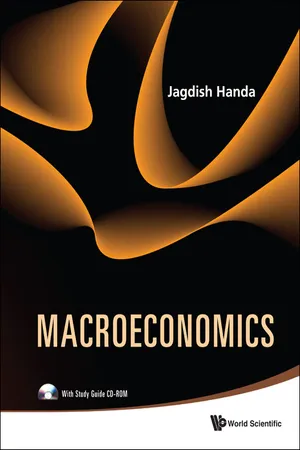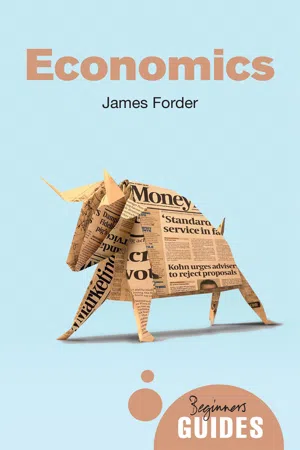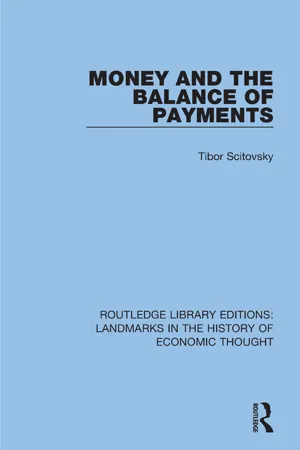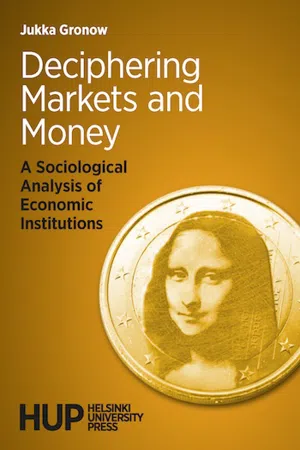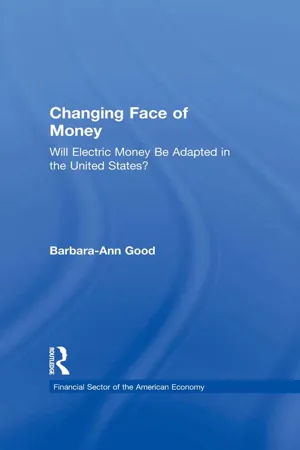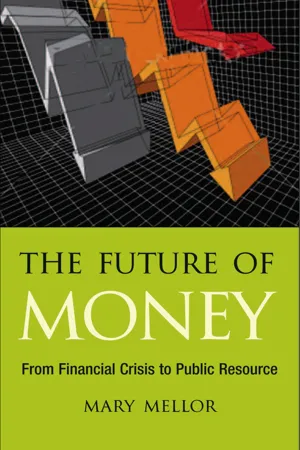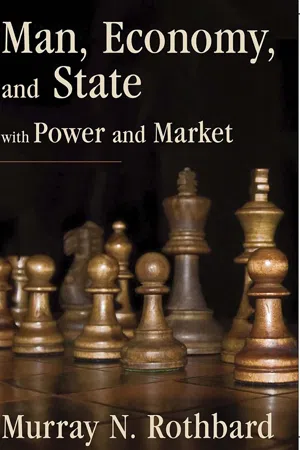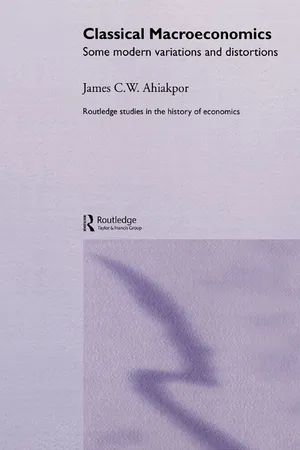Economics
Money Definition and Function
Money is a medium of exchange that facilitates transactions by serving as a universally accepted form of payment. It also functions as a unit of account, providing a standard measure for the value of goods and services. Additionally, money serves as a store of value, allowing individuals to save and transfer purchasing power across time and space.
Written by Perlego with AI-assistance
Related key terms
12 Key excerpts on "Money Definition and Function"
- eBook - ePub
Macroeconomics
(With Study Guide CD-ROM)
- Jagdish Handa(Author)
- 2010(Publication Date)
- WSPC(Publisher)
Money is not itself the name of a particular asset and is best defined independently of the particular assets that may exist in the economy at any one time, since the assets which function as money tend to change over time in any given country and among countries. At a theoretical level, money is defined in terms of the functions that it performs. The traditional specification of these functions is:(i) medium of exchange/payments, (ii) store of value, sometimes specified as a temporary store of value or temporary abode of purchasing power (iii) standard of deferred payments, and (iv) unit of account.Of these functions, the medium of payments is the most essential function of money. Any asset that does not directly perform this function — or cannot indirectly perform it through a quick and costless transfer into a medium of exchange — cannot be designated as money. A developed economy usually has many financial instruments that can perform such a role, though some do so better than others. The particular instruments that perform this role vary over time, with currency being the only or main medium of exchange early in the evolution of monetary economies. It is supplemented by demand deposits with the arrival of the banking system and then by an increasing array of financial assets as other financial intermediaries become established.2.1.2 The practical definitions of moneyHistorically, the definitions of money have measured the quantity of money in the economy as the sum of those items that serve as media of exchange in the economy. However, at any time in a developed monetary economy, there may be other items that do not directly serve as a medium of exchange but are readily convertible into the medium of exchange at little cost and trouble and can simultaneously be a store of value. Such items are close substitutes for the medium of exchange itself. Consequently, there is considerable controversy and disagreement about whether to confine the definition of money to the narrow role of the medium of exchange or to broaden it to include close substitutes for the medium of exchange. - eBook - ePub
Economics
A Beginner's Guide
- James Forder(Author)
- 2016(Publication Date)
- Oneworld Publications(Publisher)
5 Money and banksSomething that might seem peculiar about the discussion so far is that there has hardly been a mention of money. It appears as a way of measuring prices, and perhaps as something that people like to make, but apparently not as an essential component of economics at all. Part of the explanation is that – as we shall see – although money is obviously an important aspect of the functioning of modern economies, there are large parts of economic analysis where it is not nearly so important as might be supposed. It does nevertheless raise some issues of its own – issues concerning the nature of money itself; what makes something ‘money’ rather than not money; where is it that money comes from; how it is related to economic activity; and what kind of policy actions might be called for, and when?Definition of moneyDefining money is a surprisingly difficult task. The first point, though, is that in ordinary English the word ‘money’ is certainly used more broadly than it is in economics. As I have just said, ‘money’ is sometimes treated as the thing that some people like to make. But that is not an economist’s usage. Really, what those people are seeking is wealth, or perhaps income. Similarly, we might say ‘Mr Gatsby has a great deal of money’ – but it would be unlikely to mean that his wallet was at that moment particularly full.Confusion is taken further when economics textbooks provide a list of the functions of money. It functions, they say, as a unit of account, a medium of exchange, and as a store of value. ‘Unit of account’ means the measuring rod of economic value – the units in which prices are quoted. A ‘medium of exchange’ (or ‘transactions medium’) is the device commonly used to make payments, and a ‘store of value’ is a way of taking the power to make purchases that we have today, and moving that power to purchase into the future. But those are the functions of money – they are what money does. They do not exactly tell us what money is - eBook - ePub
- Shahzavar Karimzadi(Author)
- 2012(Publication Date)
- Routledge(Publisher)
7 Money originated from its functionsIntroductionIt is a customary convention of almost every economics textbook to open the subject of money by examining its essential definition. The definition most certainly revolves around one or a mixture of the functions of money. The function that cannot escape almost any definition of money is the medium of exchange. This function is inseparable from the theory of the origin of money regardless of whatever definition is being used. When combined with other functions, it can either be the dominant or the subordinate function. That is typically specified either explicitly or implicitly depending on the author’s preference as to the overriding function.Money is a contingent factual entity. It is a social and economic necessity that emerged with specific social and economic conditions. Its necessity discerns no universal law. In view of this reality then one cannot come up with a universal definition of money. The very term “define” presupposes the predicate of universality. A definition of money which can be applied everywhere and all the time is doomed to failure. Moreover, the definition of money that is not constructed from its functions would be no more than a verbal contortion. It remains in concepts that are empty of content. This is why economists either knowingly or subconsciously define money in the context of what money actually does rather than what money actually is. The definition of money then is presented as a description of its functions. Relying on the description of the functions of money leaves room for greater flexibility in case of changing economic environment and the formation of new forms of money.Defining money from its functions liberates it from its abstract form. It is much easier to describe what a form of money does rather than to give an abstract definition of it. An abstract definition that is used in all possible worlds would not last long. The possible worlds are not the same and keep changing. The four functions of money that are more or less commonly acknowledged in textbooks are the functions of money as a unit of account, a medium of exchange, a store of value and as a standard for deferred payments. The origin of money is linked to one or combination of these functions. Chapter 7 - eBook - ePub
- Tibor Scitovsky(Author)
- 2016(Publication Date)
- Routledge(Publisher)
Part A MoneyPassage contains an image
Chapter 1 The functions of moneyMoney is a difficult concept to define, partly because it fulfils not one but three functions, each of them providing a criterion of moneyness, and partly because these criteria are fulfilled to different degrees by different assets. At best, moneyness is a matter of degree, with an arbitrary dividing line between money and non-money; at worst, one might get conflicting orderings of degrees of moneyness, depending on the criterion used. In any case, our first task is to discuss the three functions of money, which are those of a unit of account, a medium of exchange, and a store of value.A. THE UNIT OF ACCOUNTThe introduction of a unit of account in which to express and compare the values of different goods and services was as important for economic life as the invention of the wheel was for technology. A common unit of account is the sine qua non of the emergence of prices—market prices as well as the central planner’s shadow prices—and these are essential both for rational economic calculation and choice by the individual, and for transmitting economic information between individuals.A common unit of account, and prices expressed in such a unit, render comparable goods and services not otherwise comparable; and such comparability is apparently necessary if the individual’s choice is to be rational, in the sense of implying a transitive (i.e., non-contradictory) ordering of preferences. There is little information on this subject so far but some experimental evidence indicates that human choice often becomes intransitive in areas where it is not facilitated by a common unit of account.1 - eBook - ePub
Deciphering Markets and Money
A Sociological Analysis of Economic Institutions
- Jukka Gronow(Author)
- 2020(Publication Date)
- Helsinki University Press(Publisher)
It is a medium of exchange, a store of value, and a unit of account. If ‘money is what money does,’ one could well argue that in order for something to deserve to be called money it has to fulfill all three functions. 2 The standard economic theory of money concentrates on one of the functions: money as a means of exchange. In these theories, money comes into being as an unintended consequence of the economic rational reasoning of the individuals. 3 As Smith believed, in order to maximize their barter options, astute traders will hold in stock some of the most regularly exchanged commodities that they expect others will accept in the future in exchange for the goods they possess. Consequently, one of these, more or less gradually, and as if by chance, emerges from among all the myriad options on offer as the general media of exchange, mainly because of its advantageous material properties, such as durability, divisibility, and portability. In various historical periods, different kinds of valuables have acted as means of exchange, for instance, furs in the Novgorod Russia’s fur trade with Western Europe or huge stone rings in ancient Polynesia. Finally, a generally accepted coinage emerges, as if crystallized out of all available options, the value of which is based on the extraordinarily high value of precious metals. The general media of exchange, or money, allows for the natural process of barter trade to develop into more extensive and general exchange of commodities, and finally to a fully fledged market economy. In these mythical genealogies of money, the traders come to realize that their life would be much more convenient if they could trade with each other using a generally accepted commodity, money. Money is, in other words, invented and based on a social contract, as if men had in ancient times come together and agreed on the use of some particular commodity as their general means of exchange - eBook - ePub
- W. Charles Sawyer, Richard L. Sprinkle(Authors)
- 2020(Publication Date)
- Routledge(Publisher)
S o far, we have examined the institutional details of the foreign exchange market and explained what determines the exchange rate. The model of exchange rate determination developed in the previous chapter explains some of the movement in exchange rates. Both the rate of inflation and the growth rate of GDP usually do not change dramatically over short periods of time, such as one day to the next. Yet, exchange rates change almost every minute of every business day. As a result, we need to expand our model of exchange rate determination to include another factor that determines or influences exchange rate movements over short periods of time. This factor is short-term interest rates. Since interest rates have an important influence on the exchange rate, we need to describe what causes domestic interest rates to change. In the first part of the chapter, we will review and expand on what you learned in your Principles of Economics course concerning the supply and demand for money and the determination of the equilibrium interest rate within a domestic economy.In the second part of the chapter, we will examine the relationship between interest rates and the exchange rate. As we will see, any change in interest rates will lead to changes in the inflows and outflows of capital in a country’s financial account and the changes in capital flows lead to changes in the exchange rate. By the end of the chapter, we will be able to examine how changes in interest rates, the exchange rate, the current account, and the financial account all interact with one another.MONEY DEFINED: A REVIEWWhen trying to determine how money affects the exchange rate, our first objective is to define the term money. Most individuals believe that they know what money is, but in fact, what constitutes money is not clear at all. The easiest way to describe money is to consider what it does. Money has to perform three separate but important functions. First, it must act as a medium of exchange. This is money’s most important function. How would economic transactions be conducted in a world without money? Without money, every price would be a relative price. For example, the price of a hamburger would be defined as what a hamburger is worth in terms of all other goods and services. In an advanced economy with a large number of goods and services, this relative pricing quickly becomes untenable. The price of one hamburger might be defined as four soft drinks or .04 tires. No one could possibly keep track of all the possible relative prices. The power of money is largely dependent on solving this relative-price problem. If there are 50,000 goods in any economy, there are only 50,000 prices. This is complicated but the alternative is far more complicated. Even if governments did not produce money, some item would emerge as a medium of exchange. In anything other than the simplest economy, something would emerge to serve as money.1 - eBook - ePub
Changing Face of Money
Will Electric Money Be Adopted in the United States?
- Barbara Ann Good(Author)
- 2014(Publication Date)
- Routledge(Publisher)
In order to understand the properties of electronic money, we must first understand the functions of money. It should become more evident that electronic money can perform the same functions as any other current form of money. Electronic money does have some additional, technical properties that allow it to be used in a slightly different manner than money has been used in the past, but these properties do not change the fact that electronic money can be used as a medium of exchange, a unit of account, and a store of value. In fact, the function of a store of value is what has given one important form of electronic money its name—the stored-value card.THE IMPORTANCE OF MONEYMonetary exchange is the alternative to barter. While in a barter system, goods are directly traded for other goods, without using money as an intermediate step, monetary exchange is a system where people trade money for goods when they purchase something and trade goods for money when they sell something.3 The single transaction of barter therefore becomes decomposed into separate transactions of purchase and sale. In the absence of money, exchange requires a double coincidence of wants—someone who has what you need also has to want what you have to trade, or to be willing to search for an additional trade for the object they want. With money, these separate transactions can occur at different times (due to the characteristic of money as a store of value).4Money’s role as a medium of exchange, an essential function of money, also allows for productivity gains that result from specialization. For example, a farmer is generally better at growing crops than he is at trading crops and money allows him to use the proceeds from the sale of his crops to buy the goods and services he needs from a merchant, rather than involving him in numerous trades to achieve the same end. With money, the merchant can also buy the products that his customers want to buy, rather than merely offering them goods he was able to acquire through trades. Money allows people to specialize in what they are able to do most efficiently and effectively, rather than being traders. - eBook - ePub
Paper Money Collapse
The Folly of Elastic Money
- Detlev S. Schlichter(Author)
- 2014(Publication Date)
- Wiley(Publisher)
The skeptical reader may at this point still raise the following objections: First, the case is built on money’s function as the medium of exchange, but standard economic textbooks also ascribe other functions to money, such as a store of value or a unit for accounting and monetary calculation. Second, the changes in money’s purchasing power that result from changes in money demand could be disruptive, as they may impair money’s role as a basis for economic calculation. Maybe it is better to adjust the money supply in response to changes in money demand than to allow money’s price to change. This would make sure that money is a reliable tool for economic calculation. Third, if money production is not needed, how can we account for the growth in banking, which for a long time has included the issuance of money substitutes and fiduciary media, the latter meaning uncovered claims to money proper that are used by the public just like money, for example, demand deposits. How can we account for the fact that the world has moved away from commodity money of fixed supply to paper money of perfectly flexible supply?These are all good and valid questions. We will address each one of them in detail in the course of our investigation. At this juncture it may just be sufficient to make the following points.All additional functions that can be assigned to money are the result of money being the accepted medium of exchange. These functions, important as they are, are derivatives of the medium-of-exchange function. Because money is the medium of exchange and every good or service is traded against money, money prices are ideal for economic calculation. As to money being a vehicle for storing wealth, it is apparent that many other assets can be used for that purpose, too. Many of these have the additional attraction of potentially generating returns over time. Money does not offer any returns. It can therefore compete with other potential storages of wealth only by offering something special, and that is its universal acceptance in exchange for goods and services, its unique marketability, the ability to be exchanged for goods and services faster and more conveniently than any other asset. That, after all, is why it is money. So we are again back to the medium-of-exchange function of the monetary asset.Certain financial assets, in particular high-quality debt claims that are traded in very liquid markets, can sometimes become “near-monies,” and their owners may thus feel a reduced need to hold money proper. But these assets are fundamentally different in that they constitute simultaneously somebody else’s liability and therefore always carry an additional risk. Proper commodity money, such as gold, but also fiat money in the form of irredeemable paper tickets, is a financial asset that is not somebody else’s liability at the same time. The purchasing power of this money varies only with changes in the demand for money and, in the case of paper money, also with changes in its inherently flexible supply. We see here that the inflexibility of supply in the case of commodity money makes it a superior store of value. - eBook - ePub
The Future of Money
From Financial Crisis to Public Resource
- Mary Mellor(Author)
- 2010(Publication Date)
- Pluto Press(Publisher)
1 WHAT IS MONEY?This is not a straightforward question. Money in its long history has been represented by many different things from precious metals, shells and beads to heavy, largely unmoveable stones. It has been made of substances that have value in themselves such as precious metals or represented by something that has no value in itself such as base metal coin or paper. Its operation has been represented in many ways from cuneiform tablets and tally sticks, to paper or electronic records. Conventional economics sees money as having a number of functions. It is a measure of value (a unit of account), a medium of exchange, a way of making deferred payments and a store of value. Money is seen as evolving with the market system. Barter is often assumed to be the original form of economic exchange with money emerging to solve the problem of finding suitable mutual exchanges. From this perspective, money is the product of pre-existing economic exchange.The chosen commodity needed to be valuable, durable, divisible and portable. Precious metals such as gold and silver were obvious choices. As a result, gold has been particularly resonant for modern conceptions of money. Gold is seen as having an inherent or intrinsic value and was adopted as a basis for money value until comparatively recently. From this ‘metallist’ perspective, the value of money still relates back to gold or some commodity that has intrinsic value although, in practice, money can be represented in many forms, such as base metal coin, paper or electronic record. This view of money leads to the assumption that money can only function effectively if it is scarce and valuable. Douthwaite argues that this view, based on the historical scarcity of gold and silver, has distorted economic theory ever since. It has led to the false idea that money can only be based on a scarce, and therefore valued, resource (1999:33). - eBook - ePub
- Murray N(Author)
- 2014(Publication Date)
- Editorial Bubok Publishing(Publisher)
11MONEY AND ITS PURCHASING POWER1. IntroductionMONEY HAS ENTERED INTO ALMOST all our discussion so far. In chapter 3 we saw how the economy evolved from barter to indirect exchange. We saw the patterns of indirect exchange and the types of allocations of income and expenditure that are made in a monetary economy. In chapter 4 we discussed money prices and their formation, analyzed the marginal utility of money, and demonstrated how monetary theory can be subsumed under utility theory by means of the money regression theorem. In chapter 6 we saw how monetary calculation in markets is essential to a complex, developed economy, and we analyzed the structure of post-income and pre-income demands for and supplies of money on the time market. And from chapter 2 on, all our discussion has dealt with a monetary-exchange economy.The time has come to draw the threads of our analysis of the market together by completing our study of money and of the effects of changes in monetary relations on the economic system. In this chapter we shall continue to conduct the analysis within the framework of the free-market economy.2. The Money Relation: The Demand for and the Supply of MoneyMoney is a commodity that serves as a general medium of exchange; its exchanges therefore permeate the economic system. Like all commodities, it has a market demand and a market supply, although its special situation lends it many unique features. We saw in chapter 4 that its “price” has no unique expression on the market. Other commodities are all expressible in terms of units of money and therefore have uniquely identifiable prices. The money commodity, however, can be expressed only by an array of all the other commodities, i.e., all the goods and services that money can buy on the market. This array has no uniquely expressible unit, and, as we shall see, changes in the array cannot be measured. Yet the concept of the “price” or the “value” of money, or the “purchasing power of the monetary unit,” is no less real and important for all that. It simply must be borne in mind that, as we saw in chapter 4 - eBook - ePub
- James C.W. Ahiakpor(Author)
- 2003(Publication Date)
- Routledge(Publisher)
Money, Credit and Commerce:Money is, firstly, a medium of exchange for bargains that are completed almost as soon as they are begun; it is a “currency”; it is a material thing carried in purses, and “current” from hand to hand, because its value is read at a glance. This first function of money is admirably discharged by gold and silver and paper based on them.(Marshall 1923:16; italics in original)The second function of money is to act as a standard of value, or standard for deferred payments—that is, to indicate the amount of general purchasing power, the payment of which is sufficient to discharge a contract, or other commercial obligation, that extends over a considerable period of time.Marshall’s description of “currency” is consistent with his 1887 testimony before the Gold and Silver Commission, in which he includes “everything which passes from hand to hand as a means of purchasing, without requiring any special or trade knowledge on the part of those who handle it,” namely, “gold, silver, and paper money” (Marshall [1887] 1926:35). Thus, Marshall excludes checks from his definition of currency, “because a cheque requires the receiver to have formed some opinion for himself as to the individual from whom he receives it” (ibid.). He similarly draws a distinction between checks and currency (money) when he observes that “In England a large purchase is generally effected, not by transfer of currency itself, but by transfer of a cheque (or other document) that gives command over currency” (43). Marshall further illustrates the substitution of checks for currency in transactions when he notes that “the total value of currency needed by the business of England is relatively small [because] her middle and upper classes discharge most of their obligations by cheques; and few of these cheques are presented for payment in cash: most of them merely transfer command over currency from one banking account to another” (46). - eBook - ePub
- John Smithin(Author)
- 2008(Publication Date)
- Routledge(Publisher)
In the classical economic sociology literature it was also Weber (1978, 2003) who made the arguments that a money of account is the prerequisite for rational accounting, the publication of price lists and financial results, and for the calculation of profit and loss generally. This view was also shared by the economist Keynes (1930, 3) who says quite clearly and unequivocally that “[m]oney-of-account … is the primary concept of a theory of money”. Ingham (2004, 21–3) explains that “money of account makes possible prices and debt contracts … money accounting, with or without an actual ‘money stuff’, is the means by which modern market exchange is made possible … producing action at both spatial and temporal distance”. In other words, for business operations to be conceivable at all there must be some mechanism whereby payments actually can be made, and profits can be realized in some socially objective form, not reducible to subjective private utilities.Money as a unit of account and means of payment
Dow and Smithin (1999), drawing on Hicks (1989), further identify an important element of a monetary economy as the existence of a unique ultimate or final monetary asset in which the twin functions of the unit of account, just discussed, and means of (final) payment are actually combined.4 Contrary to suggestions made in the “new monetary economics” (NME) literature of the 1980s (Fama 1980), these two specific functions are inseparable. The NME literature, though, tended to confuse this issue by talking mainly about the separation of functions at the level of the medium of exchange, again showing the influence of the standard barter exchange theory (Smithin 2003a). This idea of an ultimate monetary asset corresponds to what is known as base money in mainstream literature or valuata money
Index pages curate the most relevant extracts from our library of academic textbooks. They’ve been created using an in-house natural language model (NLM), each adding context and meaning to key research topics.
